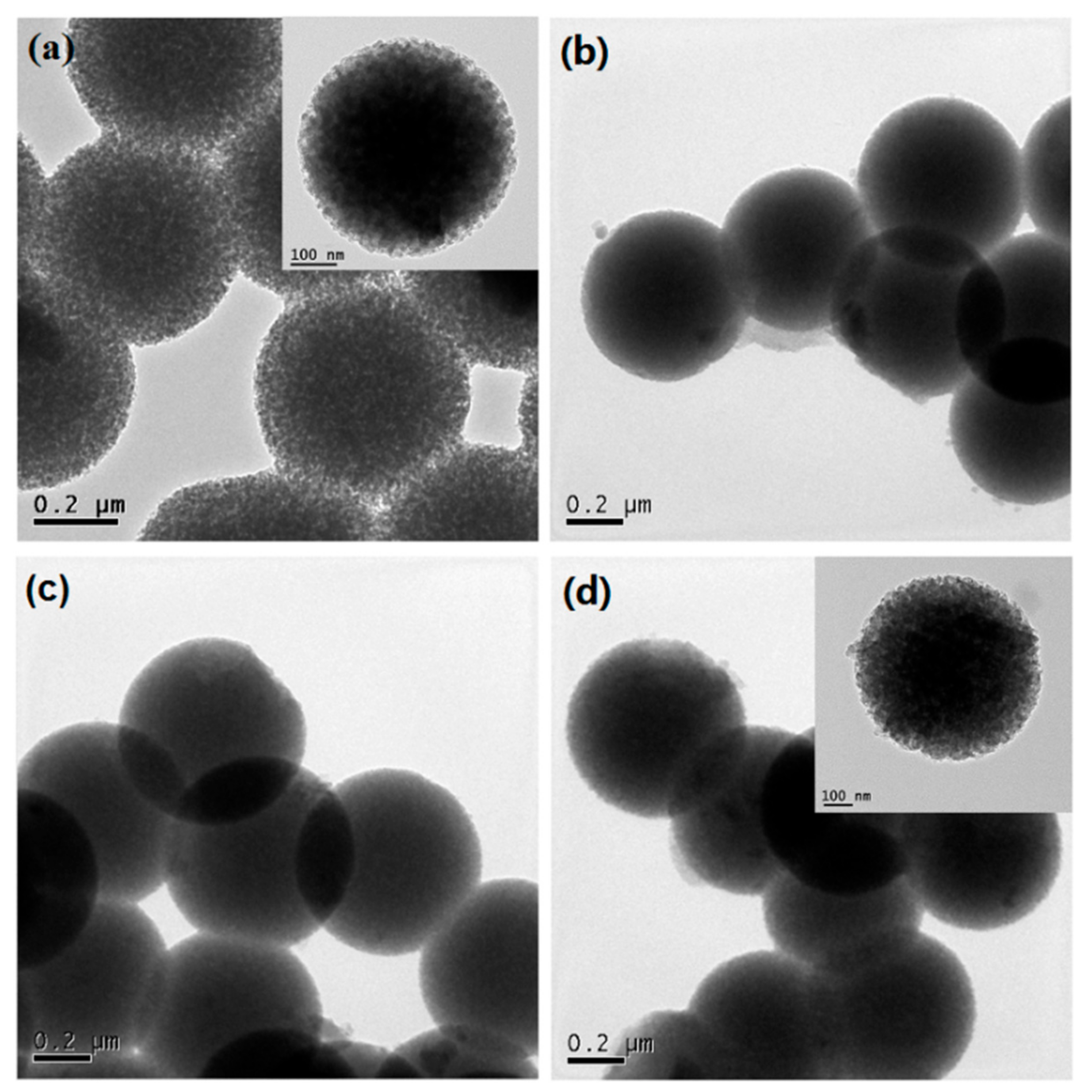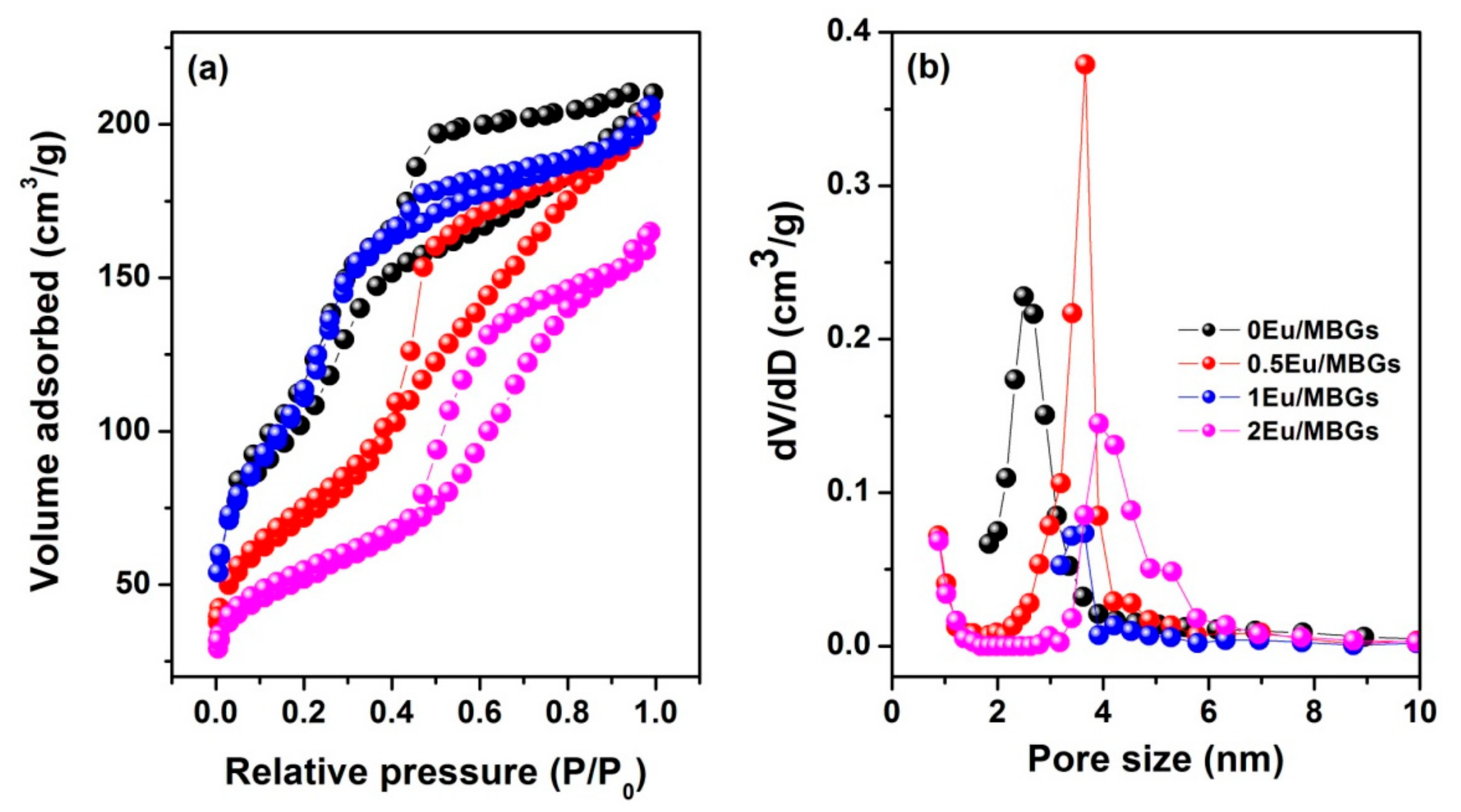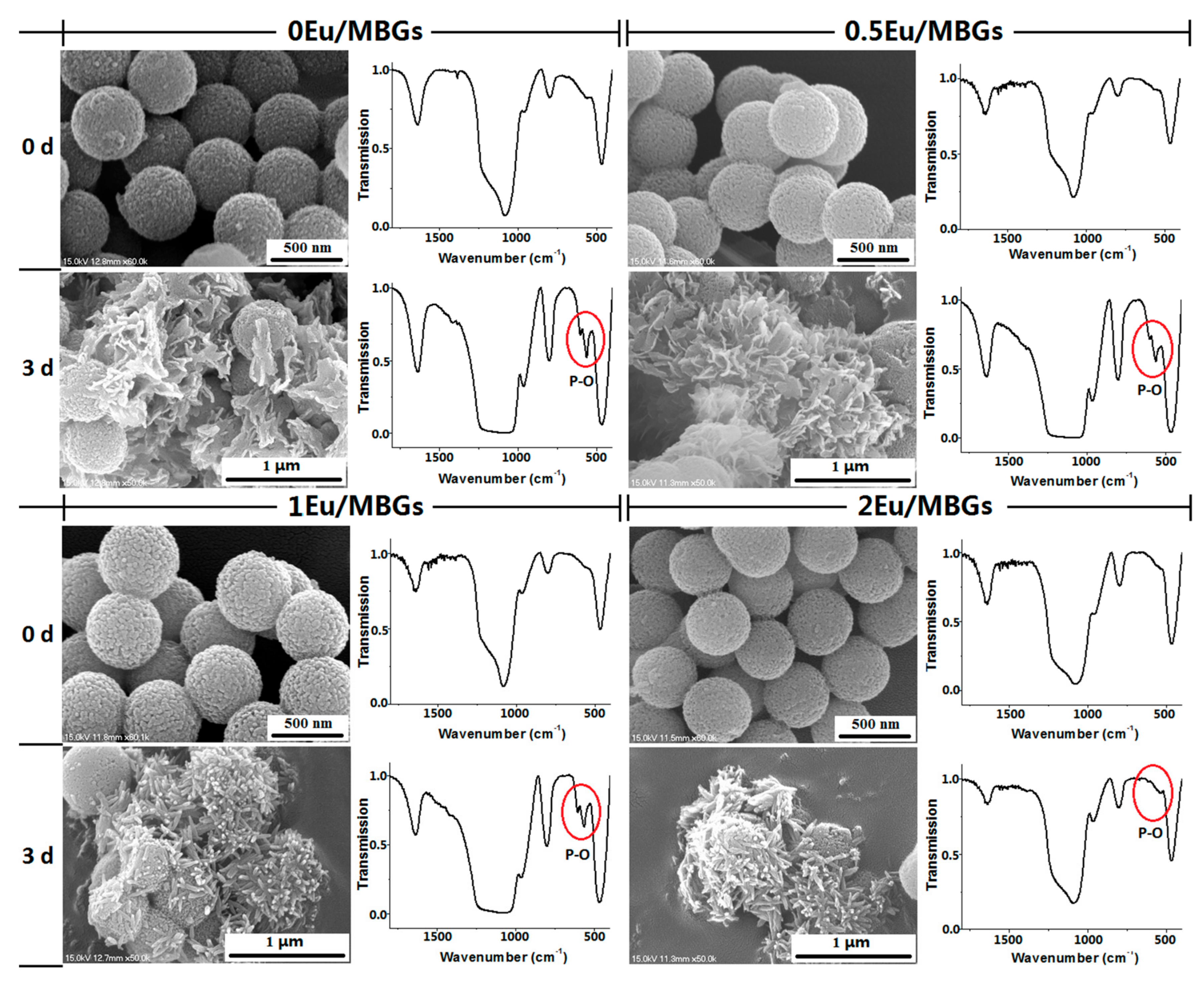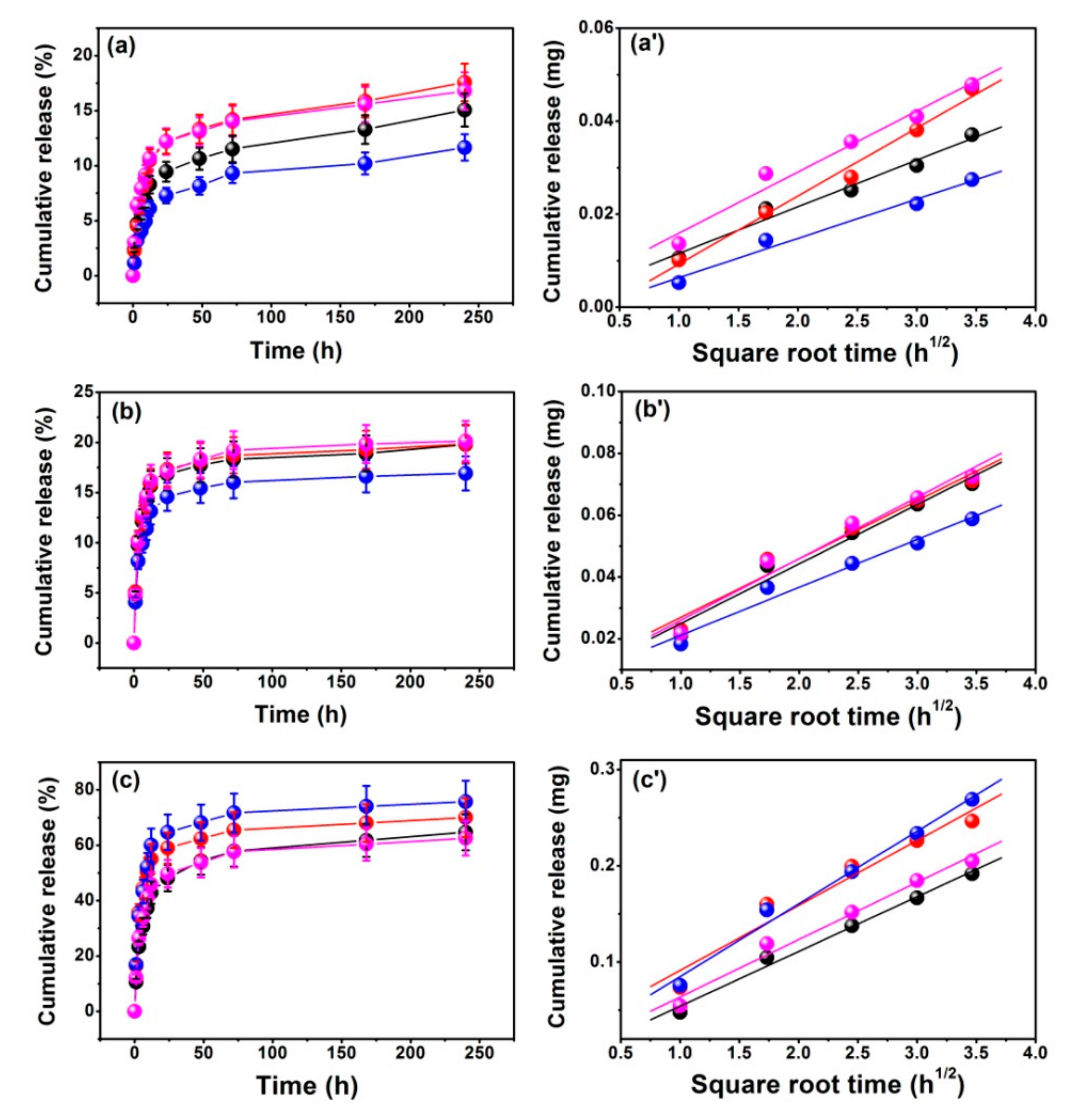Design and Evaluation of Europium Containing Mesoporous Bioactive Glass Nanospheres: Doxorubicin Release Kinetics and Inhibitory Effect on Osteosarcoma MG 63 Cells
Abstract
:1. Introduction
2. Material and Methods
2.1. Preparation and Characterization of Eu/MBGs
2.2. In Vitro Bioactivity Test of Eu/MBGs
2.3. Drug Release from Eu/MBGs
2.4. In Vitro Osteosarcoma MG 63 Cells Culture
2.5. Statistical Analysis
3. Results and Discussion
3.1. Morphology and Microstructure of Eu/MBGs
3.2. In Vitro Bioactive Evaluation of Eu/MBGs
3.3. In Vitro Drug Release of Eu/MBGs
3.4. In Vitro Osteosarcoma MG 63 Cells Culture Studies
4. Conclusions
Author Contributions
Funding
Acknowledgments
Conflicts of Interest
References
- Chen, W.Q.; Sun, K.X.; Zheng, R.S. Report of Cancer Incidence and Mortality in Different Areas of China, 2014. China Cancer 2014, 27, 1–14. [Google Scholar]
- Hoefeler, H.; Duran, I.; Hechmati, G.; Garzon, R.C.; Lorusso, V. Health resource utilization associated with skeletal-related events in patients with bone metastases: Results from a multinational retrospective-prospective observational study-a cohort from 4 European countries. J. Bone Oncol. 2014, 3, 40–48. [Google Scholar] [CrossRef] [PubMed]
- Zustovich, F.; Fabiani, F. Therapeutic opportunities for castration-resistant prostate cancer patients with bone metastases. Citi. Rev. Oncol. Hemat. 2014, 91, 197–209. [Google Scholar] [CrossRef] [PubMed]
- Seidi, K.; Neubauer, H.A.; Moriggl, R.; Jahanban, E.R.; Javaheri, T. Tumor target amplification: Implications for nano drug delivery systems. J. Control. Release 2018, 275, 142–161. [Google Scholar] [CrossRef] [PubMed]
- Jindal, A.B.; Bachhav, S.S.; Devarajan, P.V. In situ hybrid nano drug delivery system (IHN-DDS) of antiretroviral drug for simultaneous targeting to multiple viral reservoirs: An in vivo proof of concept. Int. J. Pharmaceut. 2017, 521, 196–203. [Google Scholar] [CrossRef] [PubMed]
- Liu, T.; Li, Z.H.; Ding, X.B.; Zhang, L.X.; Zi, Y.X. Facile synthesis of hollow bioactive glass nanospheres with tunable size. Mater. Lett. 2017, 190, 99–102. [Google Scholar] [CrossRef]
- Wang, X.; Wang, G.; Zhang, Y. Research on the biological activity and doxorubicin release behavior in vitro of mesoporous bioactive SiO2-CaO-P2O5 glass nanospheres. Appl. Surf. Sci. 2017, 419, 531–539. [Google Scholar] [CrossRef]
- Taygun, M.E.; Zheng, K.; Boccaccini, A.R. Nanoscale Bioactive Glasses in Medical Applications. Int. J. Appl. Glass Sci. 2013, 4, 136–148. [Google Scholar] [CrossRef]
- Shih, S.J.; Tzeng, W.L.; Jatnika, R.; Shih, C.J.; Borisenko, K.B. Control of Ag nanoparticle distribution influencing bioactive and antibacterial properties of Ag-doped mesoporous bioactive glass particles prepared by spray pyrolysis. J. Biomed. Mater. Res. 2104, 103B, 899–9073. [Google Scholar] [CrossRef] [PubMed]
- Wang, X.; Zhang, Y.; Lin, C.; Zhong, W.X. Sol-gel derived terbium-containing mesoporous bioactive glasses nanospheres: In vitro hydroxyapatite formation and drug delivery. Colloid. Surface. B 2017, 160, 406–415. [Google Scholar] [CrossRef] [PubMed]
- Borak, B.; Krzak, J.; Ptak, M.; Strek, W.; Lukowiak, A. Spherical nanoparticles of europium-doped silica–calcia glass and glass-ceramic: Spectroscopic characterization. J. Mol. Struct. 2018, 1166, 48–53. [Google Scholar] [CrossRef]
- Fan, Y.; Huang, S.S.; Jiang, J.H.; Li, G.G.; Lin, J. Luminescent, mesoporous, and bioactive europium-doped calcium silicate (MCS: Eu3+) as a drug carrier. J. Colloid. Interf. Sci. 2011, 357, 280–285. [Google Scholar] [CrossRef] [PubMed]
- Kaczmarek, M.T.; Zabiszak, M.; Nowak, M.; Jastrzab, R. Lanthanides: Schiff base complexes, applications in cancer diagnosis, therapy, and antibacterial activity. Coordin. Chem. Rev. 2018, 370, 42–54. [Google Scholar] [CrossRef]
- Wang, K.; Li, R.C.; Cheng, Y.; Zhu, B. Lanthanides—The future drugs? Coordin. Chem. Rev. 1999, 190–192, 297–308. [Google Scholar] [CrossRef]
- Farokhi, M.; Mottaghitalab, F.; Samani, S.; Shokrgozar, M.A.; Kaplan, D.L. Silk fibroin/hydroxyapatite composites for bone tissue engineering. Biotechnol. Adv. 2018, 36, 68–91. [Google Scholar] [CrossRef] [PubMed]
- Rotman, S.G.; Grijpma, D.W.; Richards, R.G.; Moriarty, T.F.; Guillaume, O. Drug delivery systems functionalized with bone mineral seeking agents for bone targeted therapeutics. J. Control. Release 2018, 269, 88–99. [Google Scholar] [CrossRef] [PubMed]
- Parent, M.; Baradari, H.; Champion, E.; Damia, C.; Viana, T.M. Design of calcium phosphate ceramics for drug delivery applications in bone diseases: A review of the parameters affecting the loading and release of the therapeutic substance. J. Control. Release 2017, 252, 1–17. [Google Scholar] [CrossRef] [PubMed]
- Liang, Q.M.; Hu, Q.; Miao, G.H.; Yuan, B.; Chen, X.F. A facile synthesis of novel mesoporous bioactive glass nanoparticles with various morphologies and tunable mesostructure by sacrificial liquid template method. Mater. Lett. 2015, 148, 45–49. [Google Scholar] [CrossRef]
- Kokubo, T.; Takadama, H. How useful is SBF in predicting in vivo bone bioactivity. Biomaterials 2006, 27, 2907–2915. [Google Scholar] [CrossRef] [PubMed]
- Hu, D.D.; Li, T.; Xu, Z.P.; Liu, D.; Zhu, L.J. Self-stabilized silk sericin-based nanoparticles: In vivo biocompatibility and reduced doxorubicin-induced toxicity. Acta. Biomater. 2018, 74, 385–396. [Google Scholar] [CrossRef] [PubMed]
- Zhu, Y.F.; Kockrick, E.; Ikoma, T.; Hanagata, N.; Kaskel, S. An efficient route torattle-Type Fe3O4@SiO2 hollow mesoporous spheres using colloidal carbon spheres templates. Chem. Mater. 2009, 21, 2547–2553. [Google Scholar] [CrossRef]
- Jiménez, J.A.; Fachini, E.R.; Zhao, C.Q. XPS and 31P NMR inquiry of Eu3+-induced structural modification in SnO-containing phosphate glass. J. Mol. Struct. 2018, 1164, 470–474. [Google Scholar] [CrossRef]
- Kozakov, A.T.; Kochur, A.G.; Nikolsky, A.V.; Googlev, K.A.; Eremkin, V.V. Valence and magnetic state of transition-metal and rare-earth ions in single-crystal multiferroics RMn2O5 (R = Y, Bi, Eu, Gd) from X-ray photoelectron spectroscopy data. J. Electron. Spectrosc. 2011, 184, 508–516. [Google Scholar] [CrossRef]
- Gómez, C.N.; Casarrubios, L.; Morales, I.; Feito, M.J.; Portolés, M.T. Effects of a mesoporous bioactive glass on osteoblasts, osteoclasts and macrophages. J. Colloid. Interf. Sci. 2018, 528, 309–320. [Google Scholar] [CrossRef] [PubMed]
- Mozafari, M.; Moztarzadeh, F.; Tahriri, M. Investigation of the physico-chemical reactivity of a mesoporous bioactive SiO2-CaO-P2O5 glass in simulated body fluid. J. Non-Cryst. Solids 2010, 356, 1470–1478. [Google Scholar] [CrossRef]
- Anand, V.; Singh, K.J.; Kaur, K. Evaluation of zinc and magnesium doped 45S5 mesoporous bioactive glass system for the growth of hydroxyl apatite layer. J. Non-Cryst. Solids 2014, 406, 88–94. [Google Scholar] [CrossRef]
- Wang, X.J.; Cheng, F.; Liu, J.; Smått, J.H.; Hupa, L. Biocomposites of copper-containing mesoporous bioactive glass and nanofibrillated cellulose: Biocompatibility and angiogenic promotion in chronic wound healing application. Acta. Biomater. 2016, 46, 286–298. [Google Scholar] [CrossRef] [PubMed]
- Huang, S.S.; Kang, X.J.; Cheng, Z.Y.; Ma, P.A.; Lin, J. Electrospinning preparation and drug delivery properties of Eu3+/Tb3+ doped mesoporous bioactive glass nanofibers. J. Colloid. Interf. Sci. 2012, 387, 285–291. [Google Scholar] [CrossRef] [PubMed]
- Huang, K.; Cai, S.; Xu, G.H.; Ren, M.G.; Zhao, H. Sol–gel derived mesoporous 58S bioactive glass coatings on AZ31 magnesium alloy and in vitro degradation behavior. Surf. Coat. Tech. 2014, 240, 137–144. [Google Scholar] [CrossRef]
- Unagolla, J.M.; Jayasuriya, A.C. Drug transport mechanisms and in vitro release kinetics of vancomycin encapsulated chitosan-alginate polyelectrolyte microparticles as a controlled drug delivery system. Eur. J. Pharm. Sci. 2018, 114, 199–209. [Google Scholar] [CrossRef] [PubMed]
- Kim, Y.H.; Tabata, Y. Dual-controlled release system of drugs for bone regeneration. Adv. Drug Delivery Rev. 2015, 94, 28–40. [Google Scholar] [CrossRef] [PubMed]
- Slowing, I.I.; Vivero, E.J.L.; Wu, C.W.; Lin, V.S. Mesoporous silica nanoparticles as controlled release drug delivery and gene transfection carriers. Adv. Drug Delivery Rev. 2008, 60, 1278–1288. [Google Scholar] [CrossRef] [PubMed]
- Cagel, M.; Grotz, E.; Bernabeu, E.; Moretton, M.A.; Chiappetta, D.A. Doxorubicin: Nanotechnological overviews from bench to bedside. Drug Discov. Today 2017, 22, 270–281. [Google Scholar] [CrossRef] [PubMed]
- Arcos, D.; Vallet, R.M. Sol–gel silica-based biomaterials and bone tissue regeneration. Acta. Biomater. 2010, 6, 2874–2888. [Google Scholar] [CrossRef] [PubMed]
- Wu, C.T.; Chang, J. Multifunctional mesoporous bioactive glasses for effective delivery of therapeutic ions and drug/growth factors. J. Control. Release 2014, 193, 282–295. [Google Scholar] [CrossRef] [PubMed]







| Order | Reagents | Dose |
|---|---|---|
| 1 | NaCl | 8.035 g |
| 2 | NaHCO3 | 0.355 g |
| 3 | KCl | 0.225 g |
| 4 | K2HPO4·3H2O | 0.231 g |
| 5 | MgCl2·6H2O | 0.311 g |
| 6 | 1.0 M-HCl | 39.00 mL |
| 7 | CaCl2 | 0.292 g |
| 8 | Na2SO4 | 0.072 g |
| 9 | Tris | 6.118 g |
| 10 | 1.0 M-HCl | 0.500 mL |
| Samples | Surface Area (m2·g−1) | Pore Size (nm) | Pore Volume (cm3·g−1) | Drug Loading (mg) |
|---|---|---|---|---|
| 0 Eu/MBGs | 401 ± 0.31 | 2.49 ± 0.05 | 0.32 ± 0.01 | 1.19 ± 0.02 |
| 0.5 Eu/MBGs | 258 ± 0.50 | 3.66 ± 0.09 | 0.26 ± 0.01 | 1.16 ± 0.03 |
| 1 Eu/MBGs | 502 ± 1.00 | 3.50 ± 0.06 | 0.34 ± 0.01 | 1.25 ± 0.03 |
| 2 Eu/MBGs | 184 ± 0.43 | 3.88 ± 0.08 | 0.11 ± 0.01 | 1.12 ± 0.02 |
| Samples | 0 Eu/MBGs | 0.5 Eu/MBGs | 1 Eu/MBGs | 2 Eu/MBGs | ||||||||
|---|---|---|---|---|---|---|---|---|---|---|---|---|
| pH 4.3 | pH 7.4 | pH 8.6 | pH 4.3 | pH 7.4 | pH 8.6 | pH 4.3 | pH 7.4 | pH 8.6 | pH 4.3 | pH 7.4 | pH 8.6 | |
| kH | 0.0569 | 0.0192 | 0.0103 | 0.0676 | 0.0189 | 0.0146 | 0.0756 | 0.0155 | 0.0084 | 0.0596 | 0.0199 | 0.0131 |
| R2 | 0.9949 | 0.9854 | 0.9886 | 0.9751 | 0.9826 | 0.9939 | 0.9936 | 0.9858 | 0.9896 | 0.9910 | 0.9838 | 0.9874 |
| slope | 0.0028 | 0.0058 | 0.0015 | 0.0237 | 0.0081 | 0.0053 | 0.0094 | 0.0056 | 0.0021 | 0.0041 | 0.0061 | 0.0028 |
© 2018 by the authors. Licensee MDPI, Basel, Switzerland. This article is an open access article distributed under the terms and conditions of the Creative Commons Attribution (CC BY) license (http://creativecommons.org/licenses/by/4.0/).
Share and Cite
Zhang, Y.; Hu, M.; Wang, X.; Zhou, Z.; Liu, Y. Design and Evaluation of Europium Containing Mesoporous Bioactive Glass Nanospheres: Doxorubicin Release Kinetics and Inhibitory Effect on Osteosarcoma MG 63 Cells. Nanomaterials 2018, 8, 961. https://doi.org/10.3390/nano8110961
Zhang Y, Hu M, Wang X, Zhou Z, Liu Y. Design and Evaluation of Europium Containing Mesoporous Bioactive Glass Nanospheres: Doxorubicin Release Kinetics and Inhibitory Effect on Osteosarcoma MG 63 Cells. Nanomaterials. 2018; 8(11):961. https://doi.org/10.3390/nano8110961
Chicago/Turabian StyleZhang, Ying, Meng Hu, Xiang Wang, Zhufa Zhou, and Yu Liu. 2018. "Design and Evaluation of Europium Containing Mesoporous Bioactive Glass Nanospheres: Doxorubicin Release Kinetics and Inhibitory Effect on Osteosarcoma MG 63 Cells" Nanomaterials 8, no. 11: 961. https://doi.org/10.3390/nano8110961
APA StyleZhang, Y., Hu, M., Wang, X., Zhou, Z., & Liu, Y. (2018). Design and Evaluation of Europium Containing Mesoporous Bioactive Glass Nanospheres: Doxorubicin Release Kinetics and Inhibitory Effect on Osteosarcoma MG 63 Cells. Nanomaterials, 8(11), 961. https://doi.org/10.3390/nano8110961






